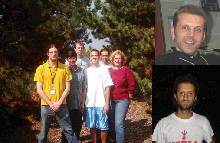 | Thursday, October 6, 2005 |
|
Thursday, October 6
Friday, October 7 |
|
Extended Forecast |
Secon Level 3 |
|
Thursday, October 6 - Southwestern Chicken Tortilla - Philly Style Cheese Steak - Chicken Pot Pie - Tomato Basil Chicken Parmesan - Southwestern Turkey Wrap - 4 Cheese Pizza - Marinated Grilled Chicken Caesar Salads The Wilson Hall Cafe accepts Visa, Master Card, Discover and American Express at Cash Register #1. |
|
Thursday, October 6 Dinner -Curried Squash -Grilled Duck with Red Wine and Fig Sauce -Wild Rice with Raisins -Almond Orange and Olive Oil Cake
Wednesday, October 5
Chez Leon Menu |
| Fermilab Today is online at: http://www.fnal.gov/today/ Send comments and suggestions to today@fnal.gov Fermilab Today archive Hurricane Relief Page Fermilab Today PDF Version Fermilab Result of the Week archive Fermilab Safety Tip of the Week archive Linear Collider News archive Fermilab Today classifieds Subscribe/Unsubscribe to |
Science, Art, Advanced Networks Meet at iGrid 2005
"We only organize an iGrid when there's a new level of technology available," said Tom DeFanti, iGrid 2005 co-chair. "This workshop was organized because of the global availability of light paths. The goal of iGrid 2005 was to build a team that knows and trusts each other, and that knows how to control and request light paths for applications and users."
|
|
From The Seattle Times October 5, 2005: 2 Americans, German share physics Nobel Two Americans and a German were awarded the 2005 Nobel Prize in physics yesterday for theoretical research explaining how lasers work and for practical developments using lasers to explore the fine structures of atoms. Roy Glauber of Harvard University will receive half the $1.3 million prize for applying quantum theory to the light emitted by lasers, a feat that reconciled the dual nature of light, which can behave like both a particle and a wave. "You don't need Glauber's theory to invent the laser, but you do need it to understand its properties," said physicist Daniel Kleppner of the Massachusetts Institute of Technology.
|
| Getting Ready for Take 2: B0s Mixing at CDF |
||
| ||
|
CDF is making breakthrough strides in measuring special types of particles, neutral B mesons, which can spontaneously convert into their own antiparticles. This conversion process is periodic and is refered to as "flavor oscillations." The B mesons are bound states of a b quark and another type of quark, and include the B0s (anti-b quark plus s quark, pronounced "Bee sub s"), and the B0d (anti-b plus d, "Bee sub d"). So far nobody has directly seen B0s mesons oscillate and only lower limits on the mixing frequency have been derived. The observation of these rapid oscillations is one of the flagship analyses at the Tevatron which is presently the only place where B0s mesons are created in sufficiently large numbers. In March 2005, the CDF collaboration put out its first analysis based on Run II data in which a lower limit on the mixing frequency has been derived (see link ). To decide whether a B meson has oscillated the flavors of the B meson at its creation and decay time have to be determined. The decay flavor can be reconstructed from the particles measured in the detector. The production flavor is determined with "flavor tagging" algorithms. These algorithms are usually quite complex and are calibrated with B+ mesons (anti-b plus u, "Bee plus"), which cannot mix, and B0d mesons, which have a mixing frequency of at least 40 times lower than B0s mesons and have been studied in detail at the B factories. A group of physicists at CDF, partly shown in the photo, has just finished this important calibration step, performing a B0d mixing measurement. Since the March 2005 calibration, CDF has improved the analysis on various fronts to squeeze more information out of the data. The improvements are in the flavor tagging algorithms, and the additions of new decay channels of the B+ and B0d mesons. The improvement of the flavor taggers has increased the effective statistics of the data by 40 percent. The measured B0d mixing frequencies are in good agreement with the world average. Further major improvements for the B0s mixing analysis are under way; stay tuned for CDF's next B0s mixing result which is expected to appear soon. |
||
|
||
| Result of the Week Archive |
|
October 3 - 5 -During this 48 hour period, two stores provided 37 hours and 52 minutes of luminosity. -Store 4431 sets New World Hadron Luminosity Record: 141.28E30
Read the Current Accelerator Update
|
|
Fermilab Folk Club Barn Dance Sunday October 9 at 6:30 p.m. with music by the thisbigstringband and calling by Dot Kent. More Information
Women's Organization Luncheon
Volunteer for Girl Scout Projects
|



